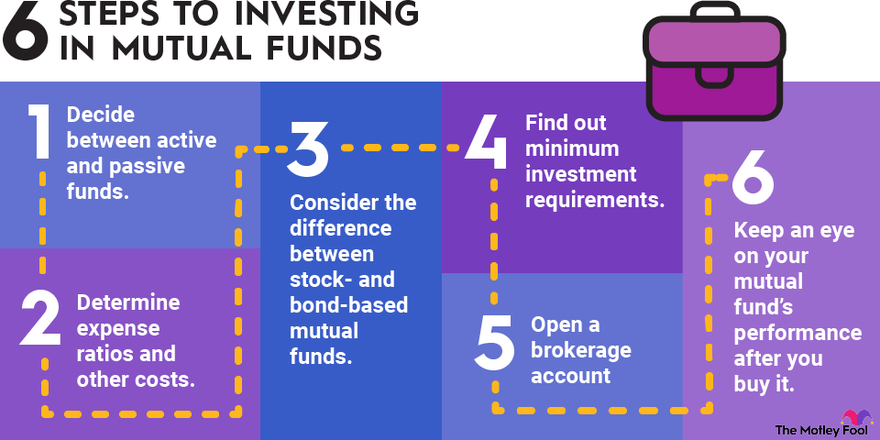A mutual fund is a collection of investment assets packaged as a single investment. Mutual funds allow investors to pool their money to invest in a diverse portfolio of stocks, bonds, or other assets. They can be a great way to get exposure to the stock market and other types of asset classes.
Here are some things you should consider as you get started, if this is your first time putting money in mutual funds. By the time you have read through this article, you will have an understanding of each of the following steps.

Active vs. passive
1. Active vs. passive funds
First, you should understand the difference between an actively managed vs. passively managed mutual fund. An active mutual fund employs managers who select investments for the fund. A passive mutual fund simply tracks a benchmark index, such as the S&P 500. The goal of an active mutual fund is to beat the performance of a particular index, while the goal of a passive mutual fund is to simply match it. For this reason, passive mutual funds are also known as index funds.
In practice, however, the majority of active mutual funds don't beat their benchmark indices. There are some excellent active mutual funds, but it's essential to take a close look at a fund's track record before investing.
Costs
2. Expense ratio and other costs
Second, you should know how much the mutual fund costs. The main type of fee you should know is the expense ratio, which is the percentage of the fund's assets that goes toward annual fees. For example, a 1% expense ratio means that you're paying $100 in annual investment fees on a $10,000 account. Passive mutual funds (also known as index funds) tend to have expense ratios in the 0.03%-0.25% range. Active mutual funds tend to have higher expense ratios because they have the added expense of paying investment managers.
Some funds charge a sales commission, known as a sales load or simply a load. A front-end load is a commission paid when you buy the fund, while a back-end load is a commission paid when you sell. That said, there are many great no-load mutual funds in the market, so you should generally avoid any mutual fund with a sales load.
Stocks vs. bonds
3. Stocks vs. bonds
You can find mutual funds that invest in many asset classes, but most invest in either stocks (equities) or bonds (fixed income). Investors should generally have some of each in their portfolio. Older and less risk-tolerant investors should generally focus more on bonds. On the other hand, younger investors are better off maintaining a more stock-heavy allocation.
One good rule of thumb is to take your age and subtract it from 110 to get a ballpark idea of your appropriate stock allocation. For example, if you're 40, you should have roughly 70% of your invested assets in stocks, with the other 30% in bonds or fixed-income investments.
How much to invest
4. Decide how much to invest
You should weigh a couple of factors when considering how much to invest. First, most mutual funds have minimum investment requirements. As an example, one of the most widely held active mutual funds, the Dodge & Cox Stock Fund (DODGX -1.34%), has a $2,500 minimum initial investment for standard accounts and a $1,000 minimum if you’re investing through an IRA. Additional investments must also be at least $100. Be sure to check fund minimums before investing.
The other consideration is how much of your portfolio should be in mutual funds, and this depends entirely on your financial needs. If you want to keep your investments on autopilot, there's absolutely nothing wrong with having a portfolio made up entirely of mutual funds. On the other hand, if you want to buy stocks as well, mutual funds can help form a nice "core" for your portfolio.
Open an account
5. Open an account
When it comes to actually buying mutual funds, you have two choices. First, you can open an online brokerage account and place your mutual fund orders there.
The brokerage route is a great choice if you want to own mutual funds from several different firms, and it can help maintain a portfolio of mutual funds and stocks in one place. A brokerage account is also a good option if you aren't sure what mutual funds you want. Many of the top online brokers have excellent mutual fund screening and research tools.
Alternatively, you can open an account and buy mutual funds directly through the companies that offer them. For example, if you want to invest in a mutual fund offered by T. Rowe Price (TROW -0.82%), you can do so directly through the company.
Managing your account
6. Keep an eye on your mutual funds after you buy them
Finally, it's worth discussing what you should do after you invest in mutual funds. Specifically, it's important to occasionally assess your portfolio and rebalance if needed. Through the natural course of market movements, you might find that your asset allocation shifts. For example, if you're targeting an allocation of 60% stocks and 40% bonds with your mutual funds, strong stock market performance could push this to 70% and 30%. In order to keep your portfolio's risk level appropriate to your situation, it's important to conduct this checkup every year or so.
Related investing topics
The Foolish bottom line
The bottom line is that mutual funds can be a great means of investing for the long term without having to worry about selecting individual stocks and bonds. By understanding the basic concepts discussed here, you'll be equipped to construct a rock-solid mutual fund portfolio of your own.
FAQ
Mutual Fund FAQs
When should I invest in mutual funds?
Any time is a good time to invest in a great fund. Don't try to time the market.
Is it worth investing in mutual funds?
If you are looking for a simple way to diversify your portfolio, investing in a mutual fund is a good choice. If you seek a relatively safe investment, pick a passively managed mutual fund (also known as an index fund) that tracks a large index such as the S&P 500.
What are mutual funds?
Mutual funds are a group of investment assets packaged into a single investment. In other words, you only buy shares of one fund via your brokerage, and you automatically own pieces of multiple companies.
Where do I invest in mutual funds?
If this is your first time mutual fund investing, you must open a brokerage account. Start there and ask your brokerage for specific guidance.











